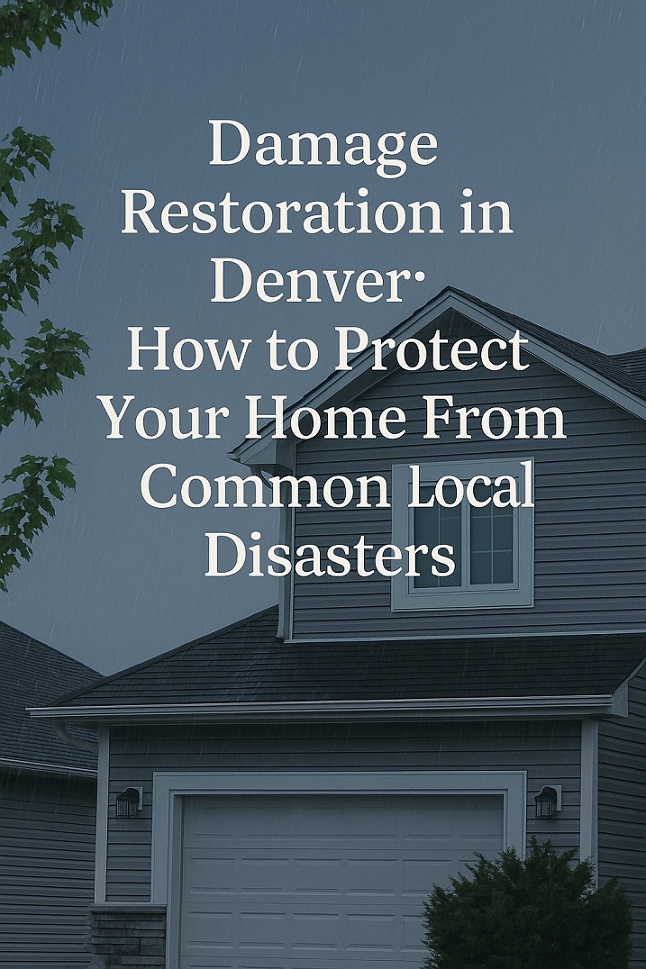Living in Denver offers a balance of urban comfort and scenic beauty, but it also brings unique challenges when it comes to property maintenance. From heavy snowmelt and plumbing bursts to wild temperature swings and seasonal storms, Denver homeowners face multiple risks that can lead to serious property damage.
Knowing how damage restoration in Denver works—and what to do when disaster strikes—can save you thousands in repairs and months of stress.
Understanding Denver’s Most Common Restoration Emergencies
1. Winter Pipe Bursts
Denver’s cold winters can cause uninsulated pipes to freeze and rupture. Even a small crack can release hundreds of gallons of water per hour, flooding walls and crawl spaces.
2. Roof Leaks During Snowmelt
As snow accumulates and melts unevenly, water can seep under shingles and cause ceiling leaks or insulation damage.
3. Basement Flooding After Heavy Rain
Denver’s clay-heavy soil doesn’t drain easily, meaning water often pools around foundations. Without a proper drainage system or sump pump, basements can quickly flood.
4. Mold Growth in Humid Areas
While Denver’s climate is generally dry, areas like bathrooms, crawl spaces, and basements can still develop mold after minor water exposure—especially if not dried properly.
The Restoration Process Explained
When damage occurs, professional response is critical. Most reputable companies follow a multi-step process to restore homes safely and efficiently.
Step 1: Emergency Response and Assessment
The team inspects the site, identifies the water source, and categorizes the level of contamination (clean, gray, or black water). Immediate actions, like water extraction and containment, begin right away.
Step 2: Water Extraction and Drying
Using industrial-grade pumps, air movers, and dehumidifiers, technicians remove all standing water and moisture trapped in walls or floors.
Step 3: Mold and Contamination Control
If water has lingered for more than 24 hours, sanitization and antimicrobial treatments are applied to prevent microbial growth.
Step 4: Repairs and Reconstruction
Damaged drywall, flooring, and structural materials are replaced, returning your home to pre-loss condition—often within days.
If you’re dealing with flooding, fire, or mold, reaching out to professionals who specialize in damage restoration in Denver ensures a faster, safer recovery. Local experts understand Colorado’s climate challenges and building codes, allowing them to tailor every step of the process to your home’s specific needs.
Why Local Experience Matters
Knowledge of Denver’s Climate
A restoration company familiar with Denver’s fluctuating humidity and freeze-thaw cycles can anticipate secondary damage like condensation behind walls or ice dams on roofs.
Faster Response Times
Local teams can respond within hours—often crucial when dealing with active leaks or spreading contamination.
Support With Insurance Claims
Denver-based restoration professionals often have established relationships with regional insurers, making the claims process smoother and less stressful for homeowners.
Preventative Measures to Reduce Future Risk
Regular Home Maintenance
- Insulate exposed pipes before winter
- Clear gutters and downspouts regularly
- Check roofing for damage after storms
Moisture Control
- Install dehumidifiers in basements
- Use exhaust fans in kitchens and bathrooms
- Inspect crawl spaces for leaks or condensation
Emergency Preparedness
Keep an updated contact list of local contractors, your insurance provider, and emergency restoration specialists. Acting fast is key to minimizing damage.
Conclusion
Denver homeowners can’t always prevent water, fire, or mold damage—but they can prepare for it. Understanding how restoration works and choosing experienced local professionals can mean the difference between minor inconvenience and major reconstruction. When disaster hits, trust experts in damage restoration in Denver to restore your home, protect your investment, and bring back peace of mind.
Would you like the 5th article to use the final homepage anchor “restoration services company”, or would you prefer to wrap the homepage links with “emergency restoration services” (a second time for variation)?

